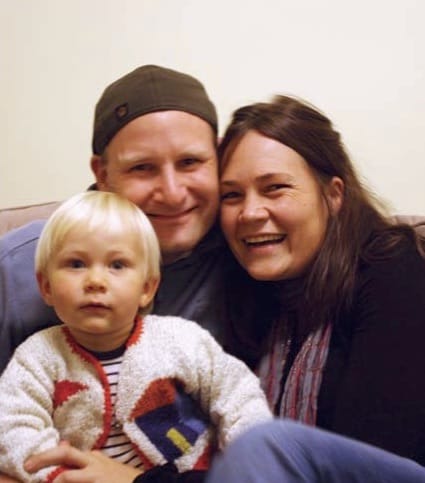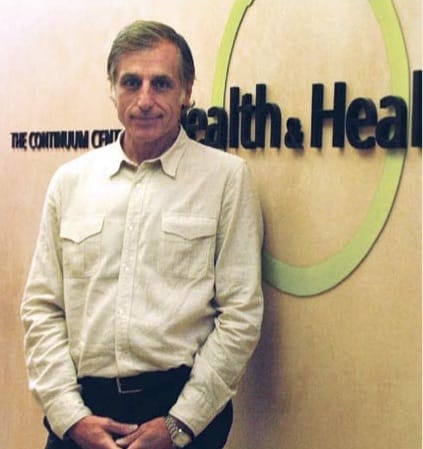How are real people are integrating mindfulness into their lives? Read four inspiring stories from our January 2011 issue.

Mindy Winter
Police officer, Madison, Wisconsin
“I’m dealing with people who are in great distress. Lives have been turned upside down.”
“At any given time, especially when you’re likely to arrest somebody, you have to expect that things could get very ugly, very quickly,” says officer Mindy Winter of Wisconsin’s City of Madison Police Department. “You have to be ready for that,” she says, “but, it’s a fine line to walk. You can’t let your concern for officer safety negatively affect the way you deal with the public.”
Policing is a stressful job, Winter acknowledges. “So, it’s important to find constructive outlets. It’s easy for anyone, not just police, to fall into less healthy ways of dealing with stress.”
Mindfulness is Winter’s constructive outlet. She was introduced to it about seven years ago when her romantic partner took a mindfulness course and came home talking about it. Now, Winter regularly meditates focusing on the breath. Sometimes she practices for just a few moments, sitting at her desk in the middle of her day. At other times she sits for longer periods at home.
“It’s mind-boggling that more people don’t stop and breathe,” says Winter. “Our society is so go-go-go. Do this, do that, do sixteen things at once. I think we all need to take a breather every now and then and not think about things.”
For the first five years that Winter was a police officer, she worked a beat. About a year ago, she became a traffic crash investigation specialist, which means that when there is a major car accident in her area, she’s on the scene. “I’m dealing with people who are in great distress, because a loved one has just died or they or their loved one is in a serious medical situation,” Winter says. “Lives have been turned upside down.”
The trauma of seeing “what’s under the sheet” and dealing with tragedy day in and day out can make some officers shut down emotionally. But, Winter says, mindfulness grounds her and enables her to be there for people in a more compassionate way. “Having a mindful perspective helps me be more patient and understanding than I would be if I weren’t thinking along those lines.”
The City of Madison Police Department is supportive of employees using mindfulness. Last year, her training team even offered a retreat held in Madison as an optional specialized training. This retreat was led by Sharon Salzberg, cofounder of the Insight Meditation Society in Massachusetts, and Cheri Maples, a former officer with the City of Madison Police Department. “It ran the whole gambit,” Winter says. Participants had group discussions, practiced walking and sitting meditation, and listened to talks. The retreat activities “kept your mind going, but relaxed your mind at the same time.”
Winter and several other participants were so inspired by the retreat they decided to continue meeting. “We get together once a month,” she tells me. “We have lunch and talk about meditation. This group has been amazing. We didn’t really know each other before the retreat, but mindfulness has been a way for us to get to know each other.”
 Toni Bernhard
Toni Bernhard
Former law professor, Davis, California
“When I breathe out compassion, I feel a powerful connection to the millions of people suffering from chronic conditions.”
To celebrate her twentieth year as a law professor, Toni Bernhard and her husband took a vacation in Paris. But from the beginning of that 2001 trip, Bernhard was so sick that she was stuck in bed and barely got to have a glimpse of the Eiffel tower. According to several doctors, it was probably during the flight on the way over that she contracted the virus from which she has never recovered.
At the point when Bernhard got sick, she’d been attending Buddhist meditation retreats for ten years and had an established sitting practice. She sat for forty-five minutes every day, never skipping, not even on her children’s wedding days. But after becoming ill, her physical discomfort made meditation too difficult to do. “As a result,” she says, “I felt like a failure as a Buddhist, and it took several years for me to return to the dharma. Slowly, though, I came to realize the Buddha’s path is not a one-fold path. It’s eightfold. There are many other practices besides formal meditation.”
In fact, Bernhard has discovered that many of non-formal mediation practices have a more profound effect on her now than they did when she was well. Before her illness, for instance, she’d learned an altruism-cultivating meditation called tonglen, which involves visualizing taking in others’ pain on the in-breath and sending out relief on the out-breathe. As a healthy person, Bernhard had rarely practiced this, but now she does so regularly. She says, “When I breathe in the suffering of everyone unable to socialize with family and friends because of health problems and I breathe out compassion, I feel a powerful connection to the millions of people suffering from chronic conditions.”
That connection has not only eased her own suffering; it has also inspired her to help others by sharing with them the practices that have helped her. Lying in bed, her laptop pressing into her stomach, she wrote the practices down, both the traditional Buddhist ones and those of her own inspiration. Sometimes, months went go by and she was too ill to write, but finally she completed a manuscript. Now it’s a book, How to Be Sick: A Buddhist-Inspired Guide for the Chronically Ill and their Caregivers, which was released in September by Wisdom Publications.
Bernhard can’t pinpoint which practice has been most useful to her; in the course of a week, she uses them all. But one that many people gravitate to is cultivating compassion for their body by repeating a particular phrase. She says, “I often use these words: My sweet body, working so hard to feel better. This phrase resonates strongly with people because it allows them to see that the aversion they’ve had toward their innocent body has been a great source of mental suffering.”
“Mindfulness practice helps loosen the tight-fisted grip of stressful emotions and thoughts,” Bernhard continues. “By bringing these painful mental states into mindful awareness, we can then see them for what they are—impermanent and not a fixed part of our identity. We are not just this illness. We are not just this bodily pain.”
 Alex Tower Ewers & Patrick Ewers
Alex Tower Ewers & Patrick Ewers
Parents, Mill Valley, California
“I wish every pregnant woman had the opportunity to take this class”
When Alex Tower Ewers was in her second trimester, she and her husband Patrick Ewers began a course on mindfulness-based childbirth and parenting, which met one evening a week for two months. Sessions included formal meditation, group discussion, and partner work.
“I wish every pregnant woman had the opportunity to take this class,” Tower Ewers says. “Whether you’re at home or in the hospital, having a caesarian or are doing natural childbirth, it’s enabling to know how to be present and be okay with whatever your circumstance is.”
Our minds usually dwell in the past and the future. In the birthing room, this can mean that a woman gets wrapped up in fear of the next round of contractions instead of resting or gathering her energy between them. And it can lead to her partner, who sees her pain, to feel helpless and to spin into panic mode. “Panic mode is something I avoided by staying in the present moment,” Patrick Ewers says. “Every once in a while I would slip into future-thinking, but through practice I was able to pull myself back and think what’s important is what can I do for my wife right now.”
One practice the couple learned, which they found particularly useful, involved dealing with pain. The instructor provided participants with bowls of ice water and they took turns submerging their hands for a minute. It was painfully cold, says Tower Ewers, and “each time we did it, we had to use a different way of coping. The first time the instructor let us do whatever we would instinctively do. Most of us yelled and screamed and said every cuss word you could think of. Then we tried several other techniques.”
One was to focus on the breath. Another was to choose a word or sound, such as Om, and focus on that. The instructor encouraged participants to experiment with diving into the pain—to experience it as deeply as they could—and also to experiment with distracting themselves from the pain, perhaps by thinking about being on a beach in Hawaii. Experimentation was the key, and participants were encouraged to devise their own coping strategies, for instance, staring into their partner’s eyes or singing or having their partner massage their back.
“The point of the exercise,” says Tower Ewers, “was to see how much the mind affects our physical level of pain. Most people finished this exercise saying something to the effect of, ‘When I focused on Om, it only seemed like we had our hands in water for three seconds, but when I yelled and screamed and went on about it being uncomfortable, it felt like five minutes.’ After doing the ice water exercise, we became aware that we have the ability to change how we experience physical pain. There are tools that the mind can use to either have pain be excruciating or bearable.” The mothers-to-be in the class were then able to take what they’d learned and apply it to labor.
The Ewers opted for a natural childbirth at home. “We had an exceptional birth experience,” says Patrick Ewers. It was a relatively easy labor, and complication free. “We can’t say that just our mindful practice caused that to happen,” he continues. But when people are tense or have a lot of expectations about how they want things to unfold, complications can arise and sometimes one complication can lead to another. “We feel that because of the approach we took, we increased the likelihood of a positive experience.”
 Dr. Martin Ehrlich
Dr. Martin Ehrlich
Internist, New York City
“It’s an amazing process to do this within myself, and also do it together with patients”
When internist Dr. Martin Ehrlich is walking down the hall and realizes that he’s rushing, he tries to stay with that realization and take a deep breath; between patients, when he’s washing his hands, he consciously focuses on letting go of his last patient so that he can be present for the next one; and when he’s touching patients—when he’s listening to their heartbeat or asking them to breathe—he breathes with them. All of the above are common occurrences in Ehrlich’s routine, but instead of seeing them as mundane or unimportant, he uses them as reminders to be mindful.
Ehrlich was already practicing medicine when he was introduced to meditation by his wife, a Sufi, and though he doesn’t identify as a Sufi himself, he says that Sufi meditation has helped him in his interaction with patients. The meditation that’s practiced in the Sufi tradition involves focusing on love—on taking everything into the heart. With the aid of this meditation, says Dr. Ehrlich, “I could connect on an emotional level with people more than I’d ever done before. It gave me a better sense of where people were at.” But, for Dr. Ehrlich, Mindfulness Based Stress Reduction (MBSR) has also had a profound effect.
Ehrlich practices in New York at the Beth Israel Continuum Center for Health and Healing, one of the largest integrative medicine centers in the United States, and for years before taking an MBSR course himself, he was recommending it to patients. He says, “These were people who were dealing with all kinds of problems—chronic stress, chronic pain, depression, insomnia, irritable bowels—and pretty much unanimously I would get incredible feedback.” Patients would come back from an MBSR program saying, “It changed my life.”
When Ehrlich became the medical director of the Continuum Center, he invited an MBSR teacher to begin leading programs there, and finally Ehrlich himself took the course. Since then, he too has noticed enormous changes in his life, principally in how he deals with stress.
“I was known for not having the gentlest temper and I didn’t like that about myself,” he says. “I would become irritable and always be sorry afterwards. It would happen with coworkers and family members, and it would happen occasionally with patients. I’m still far from perfect—I have lapses. But I’m aware of them almost as they’re happening, so I’m able to not be as reactive.”
In the past, Dr. Ehrlich found that he didn’t necessarily take his irritation out on his patients directly, but he would lose connection with them—lose compassion. “Sometimes, as a busy doctor, you get concerned with the clock,” he says, especially when patients take up more than their allotted time. In this situation, Ehrlich often used to get nervous and cut his attention off, rushing the patient. Now, he’s more aware of his thoughts and emotions and can verbalize his concerns, saying something like: We’ve run out of time. I know we haven’t finished everything, so let’s meet again soon. “I’m more in touch with the needs, or unmet needs, of the patient,” he says.
Dr. Ehrlich encourages his patients to be aware as well. “To the extent that I can, I teach them to pay attention to their own symptoms and their own mindset, and get them to look at their thoughts, bodily sensations, and emotions as temporary things that come and go. It’s an amazing process to do this within myself, and also do it together with patients.”
